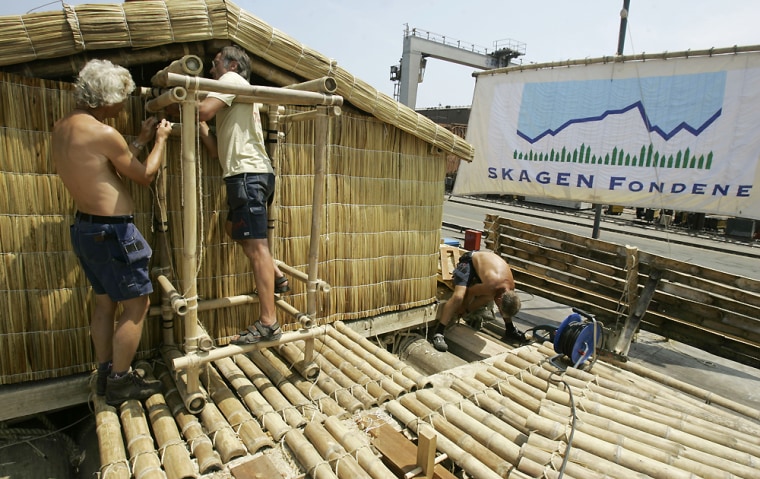Nearly 60 years after Thor Heyerdahl’s Pacific Ocean crossing aboard the balsa raft Kon-Tiki, a Norwegian team is in Peru putting final touches on a new vessel to repeat the journey.
“I think we are mentally prepared and we are really, really anxious to put this raft in the ocean,” said Olav Heyerdahl, 28, the adventurer’s grandson and one of the six-member crew.
Behind him in a dry-dock in Lima’s port of Callao loomed the balsa raft Tangaroa — named for the Polynesian god of the ocean — which is scheduled to set sail April 28.
The expedition had been set for last year, but was postponed after key sponsors diverted funds to help victims of the 2004 Southeast Asian tsunami.
In 1947, Thor Heyerdahl and his team sailed their primitive raft 5,000 miles (8,000 kilometers) from Peru to Polynesia in 101 days to support Heyerdahl’s theory that the South Sea Islands were settled by ancient mariners from South America. Heyerdahl, who died in 2002 at age 87, documented his voyage in the best-selling book “Kon-Tiki” and in an Oscar-winning documentary film.
The adventurer’s 67-year-old son, Thor Heyerdahl Jr., came to Peru to see the new vessel and cheer on his own son. “I’m very happy for him that he gets this opportunity,” he said.
The new 56-foot (17-meter) vessel is larger than the Kon-Tiki, with eight crossbeams lashed to 11 balsa logs from Ecuador and covered by a bamboo deck. Atop a hardwood cabin, the crew fitted a thatched-reed roof made by Aymara Indians.
The Kon-Tiki carried only the most basic equipment, even by 1947 standards. But the Tangaroa features abundant modern technology, including solar panels to generate electricity and satellite navigation and communications gear.
“We have seen this project grow from just an idea, a dream, and then suddenly you are 10 days away from being on the raft on the sea,” said Swedish filmmaker Anders Berg, who will document the journey. “It’s like pregnancy, I would say.”
The Kon-Tiki was equipped with a primitive sail and could not navigate against the wind. Its journey ended when it foundered on a reef near Tahiti.
But research has shown that prehistoric Peruvian sails were actually much better than Thor Heyerdahl could have imagined in 1947, according to team leader Torgeir Saeverud Higraff. A large, square sail of woven Peruvian cotton of a kind commonly used before the European conquest will be mounted on the Tangaroa this week.
Spanish chroniclers wrote centuries ago of Inca lords who sailed the Pacific on large, navigable balsa vessels nearly 70 years before the conquistadors came to Peru in 1532, he said.
The expedition is a $800,000 venture backed by the Norwegian Environment Ministry, private businesses and Heyerdahl’s hometown of Larvik, Norway.
